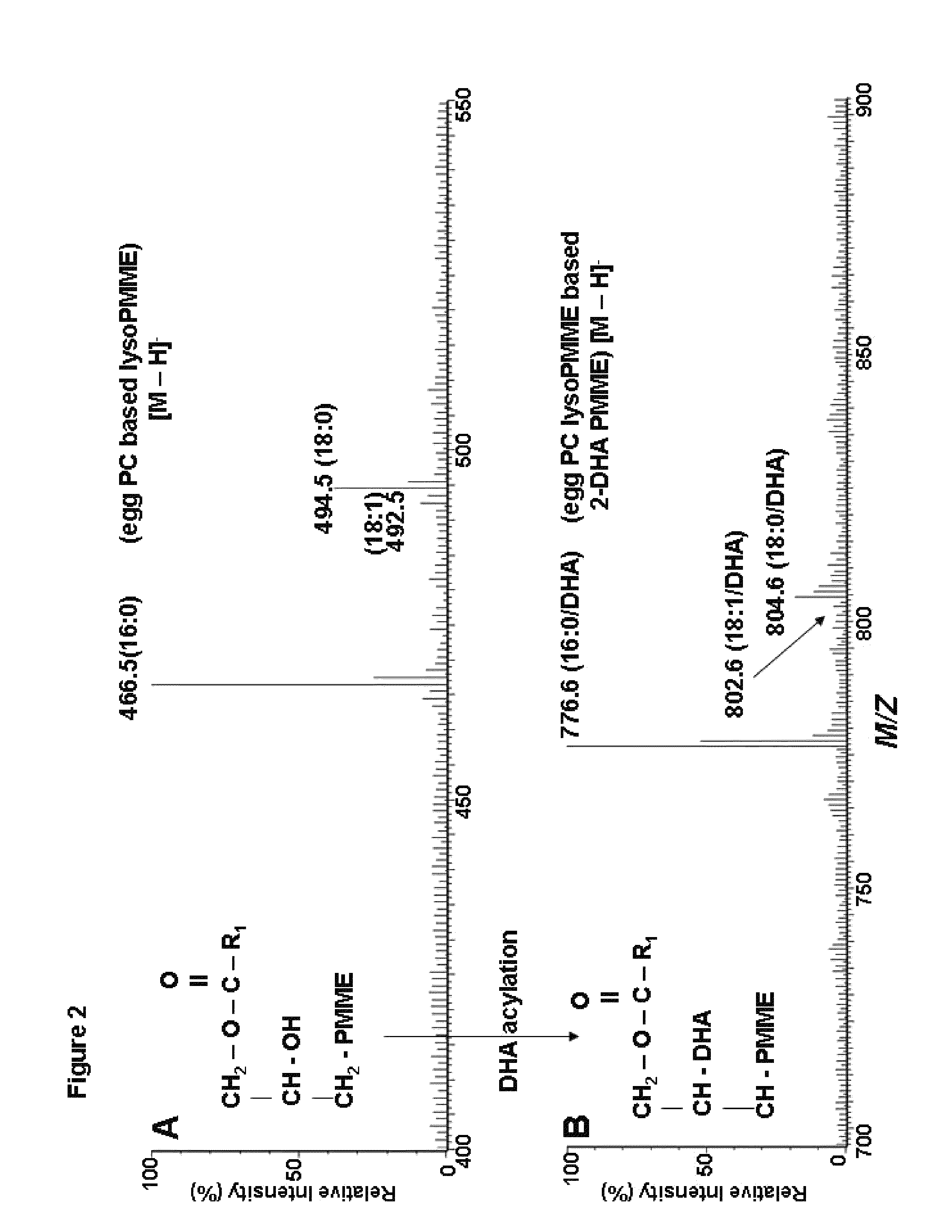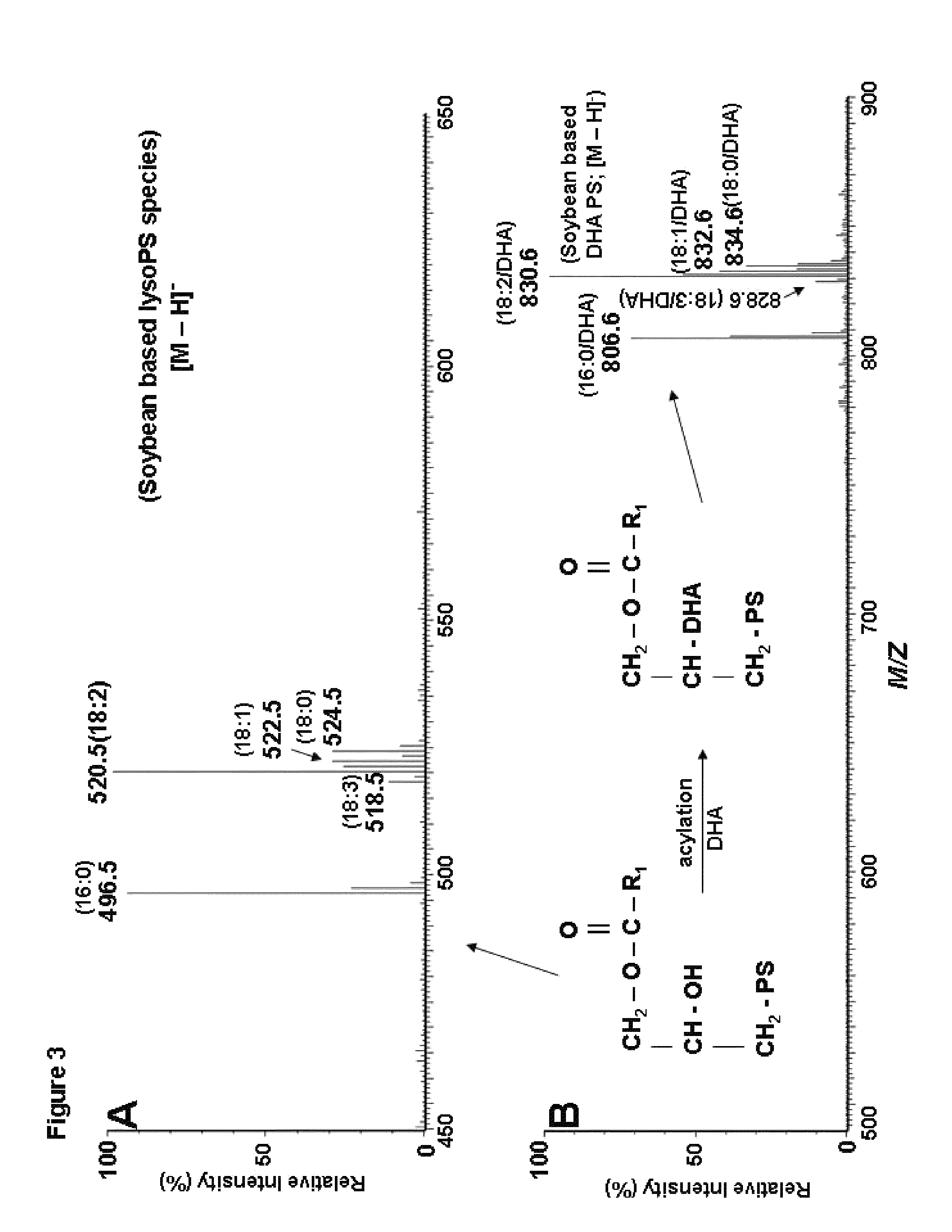Composition and method for promoting survival of aged basal forebrain cholinergic neuron leading to provention and treatment of age-related neurodegenerative disorder
a cholinergic neuron and basal forebrain technology, applied in the direction of biocide, drug composition, active ingredients of phosphorous compounds, etc., can solve the problems of brain dha deficiency, difficult or even impossible cure, and questionable qualification of lipid mixtures
- Summary
- Abstract
- Description
- Claims
- Application Information
AI Technical Summary
Benefits of technology
Problems solved by technology
Method used
Image
Examples
example 1
Preparation of Highly Enriched 1-acyl Chains / 2-DHA Species of Highly Pure Phospholipids
[0071]Preparation of Highly Enriched 1-acyl Chains / 2-DHA PE Species (See the Following Chemical Structure)
[0072]
[0073]Method 1:
[0074]PE was purified from crude soybean phospholipids by silica chromatography. About 500 mg of lysoPE species mixture was obtained after PLA2 treatment of about 5 grams of purified soybean PE (see FIG. 1A). A solution was made by stirring 550 mg of free DHA (BIOMOL, Plymouth Meeting, PA, USA), 350 mg of dicyclohexylcarbodiimide and 200 mg of 4-(dimethylamine) pyridine in 20 mL of chloroform for 60 min [Selinger and Lapidot, Synthesis of fatty acid anhydrides by reaction with dicyclohexylcarbodiimide, J. Lipid Res. 7,174 (1966)], and then added to a container containing about 500 mg of the lysoPE species. The vial was fully filled with argon and then put into another container in which nitrogen was fully filled. It was left to react at 40° C. for 2 hours. The reaction mix...
example 2
In vitro Metabolic Profiles of Highly Pure Phospholipids Incubated with the Pancreatic Phospholipase A2, in Order to Evaluate the Specificity of DHA Phospholipid Species for the Enzyme
[0083]The experiment was done on the basis of the published method [Singh and Subbaiah, modulation of the activity and arachidonic acid selectivity of group X secretory Phospholipase A2 by sphingolipids, J. Lipid Res. 48, 683 (2007)]. Briefly, highly pure PE was incorporated into liposome by sonication. The reaction mixture for assay of the pancreatic PLA2 (2 units) contains 100 μM the DHA phospholipid, 100 mM Tris / Cl (pH 8.0), 0.1% bovine serum albumin, and 10 nM CaCl2 in a final volume of 200 μl. The incubation was carried out for 30 min at 37° C. After extraction with the method of Blign and Dyer, the lipids were analyzed by the liquid chromatography / mass spectrometry. The same experiment was also done using highly pure PMME as substrate, as mentioned above. It is clear to see that the two brain DHA...
example 3
In vitro Metabolic Profiles of Highly Pure Phospholipids Incubated with the Human Secratory Phospholipase A2 Group V and Group X, in Order to Evaluate the Specificity of DHA Phospholipid Species for the Enzymes
[0084]Recombinant human secretory PLA2 Group V and Group X, which were used in the experiment, can be generated in the mammalian systems and act more readily on lipoproteins and cell membranes [Cho, Structure, function and regulation of Group V phospholipase A2, Biochim. Biophys. Acta. 1488, 48 (2000)]. The specific activity of the enzymes was calculated as micrograms of fatty acid released from purified soybean PC and was corrected for the value of the control samples, in which the substrates were incubated in the absence of the two enzymes.
[0085]A substrate of PE DHA species in a natural lipid mixture used in experiment was made by transphosphatidylation of fish liver PC [Chen and Subbaiah, Phospholipid and fatty acid specificity of endothelial lipase: potential role of the ...
PUM
| Property | Measurement | Unit |
|---|---|---|
| volume | aaaaa | aaaaa |
| pH | aaaaa | aaaaa |
| thickness | aaaaa | aaaaa |
Abstract
Description
Claims
Application Information
 Login to View More
Login to View More - R&D
- Intellectual Property
- Life Sciences
- Materials
- Tech Scout
- Unparalleled Data Quality
- Higher Quality Content
- 60% Fewer Hallucinations
Browse by: Latest US Patents, China's latest patents, Technical Efficacy Thesaurus, Application Domain, Technology Topic, Popular Technical Reports.
© 2025 PatSnap. All rights reserved.Legal|Privacy policy|Modern Slavery Act Transparency Statement|Sitemap|About US| Contact US: help@patsnap.com



